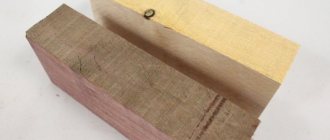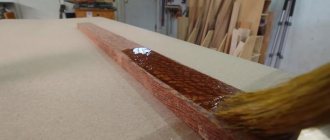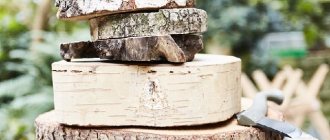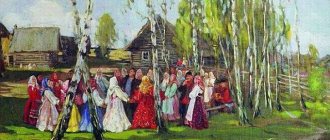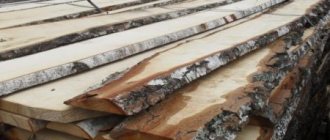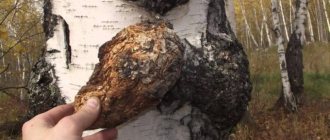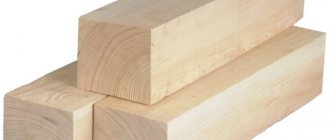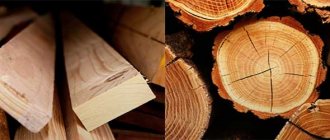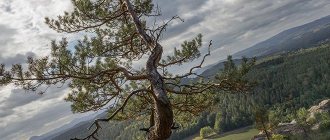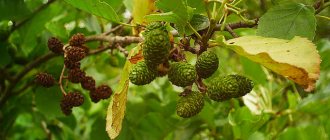The genus and its representatives
Olga Nikitina
The genus Birch (Betula) belongs to the birch family (Betulaceae) and has about 120 species. The sizes of representatives of this genus are very different: from giants 30 (45) m high with a trunk diameter of 120–150 cm to creeping dwarfs that barely rise above the ground. The root system is powerful, depending on the type and growing conditions, it can be either superficial or deep. The bark is usually smooth, peeling off in thin sheets, most often white, yellow or pink, but in some species it can be gray, brown or even black.
The leaves are petiolate, from round and obovate to lanceolate, entire (less often lobed), serrated along the edge, with pinnate venation. Small, inconspicuous flowers are collected in staminate and pistillate catkins. The fruit is a single-seeded nut with membranous wings.
Birch grows slowly only in the first years of its life, then this process accelerates, which ensures its victory over many other tree species and herbaceous vegetation. The age limit for most species does not exceed 100–120 years, but some trees can live up to 300.
Birch is the most common tree species in the Northern Hemisphere and the most common deciduous species in Russia.
Birch blossom
Most birch trees are very frost-resistant, do not suffer from spring frosts, and some even tolerate permafrost. The most thermophilic ones are found in the subtropics. Birch trees are undemanding to soil quality. They can grow on sandy and loamy, rich and poor, wet and damp soils. Some species have adapted to the swampy soils of the tundra, dry rocky slopes and even hot dry steppes. Most birch species are light-loving, although some are quite shade-tolerant.
Birch is one of the most widespread genera in the Northern Hemisphere. In the forest zone of the temperate zone it is a forest-forming species. Many species can be called pioneers in clearings and fires, where they are able to form pure stands.
Many species of birch are pioneers in settling clearings, burnt areas, wastelands and outcrops (such as the Silver Birch ( Betula pendula
)): in these places, pure birch stands (secondary forests) are often observed, mainly of the grass type, so birch is often classified as a soil-improving species.
Systematically, the Birch genus is not simple and is divided into four sections.:
Section Nanae includes dwarf birch trees. They are able to withstand difficult growing conditions (tundra zone), which has left a corresponding imprint on their appearance. These are, as a rule, creeping or shrubby birches with very small leaves: b. dwarf (B. nana), b. Middendorf (B. middendorfii), b. skinny (B. exilis). Such low-growing species look very good on small alpine hills.
The section Acuminatae includes birches that grow only in the subtropics, for example b. Maksimovich (B. maximowiczii), b. shiny (B. luminifera).
Albae section includes birches with mostly white or light-colored bark - usually trees or large shrubs. This includes the most common types of b. in our country . fluffy (B. pubescens) and b. pendulous (B. pendula). Some external similarity of these species implies different growing conditions. The first prefers well-moistened soils, the second prefers sand and rocky areas. Walking through the birch forest, on the hills and small hills, you will definitely see b. hanging with a luxurious weeping crown. In the lowlands, along streams, you will certainly come across b. fluffy.
When people talk about birch trees, quite often, even non-experts, remember the famous birch tree. Karelian (B. pendula var. carelica), which has highly sinuous wood fibers, giving a particularly beautiful moire pattern in products made from it. In addition, b. Karelian looks very attractive, which allows it to be used in landscape design. A.Ya knew everything or almost everything about this birch. Lyubavskaya is a world-famous scientist who for many years headed the department of selection, genetics and dendrology at the Moscow Forestry Institute (now Moscow Forestry University). She trained a huge galaxy of scientists who still work in various regions of our country.
Paper birch (B. papyrifera) is native to the Rocky Mountains of North America. This is a tall, slender tree up to 30 m high and up to 1 m in diameter, with white or pinkish bark.
Costatae section includes birches with a variety of bark colors (white, yellow, cherry, black), they have harder wood, leaves with veins pressed in from above and strongly protruding from below, which gives them some roughness. Chinese white birch (B. albo-sinensis) is a tree of the first size, up to 30 m high and up to 120 cm in diameter, with bright orange and thinly curled bark. It is rarely found in cultivation, as it suffers greatly from frost. Recently, European nurseries have begun to grow its variety 'Septentrionalis' , which has orange-brown bark and is more resistant to frost.
North American b. black (B. nigra) grows very quickly, but is short-lived. It has an openwork, ovoid crown and a trunk covered with reddish-brown bark. This species is valued for its strong brown wood, but, unfortunately, does not form tall, straight trunks, since at a height of 5 m it usually splits into several branches.
Cherry birch (B. lenta) is a tree up to 25 m high with a rounded transparent crown, the bark is dark, reddish-brown, in young trees it is very fragrant and has a spicy taste. In spring, this birch is decorated with long, hanging stamen catkins.
Erman's birch (B. ermani) is distinguished by brown bark, which often hangs on the trunks and branches in rags, which do not at all spoil the appearance of the tree. This birch of Far Eastern origin has fairly strong wood and high drought resistance.
Birch is considered a soil-improving species. Often it is the first to appear in wastelands, in areas of clearings and burnt areas. Helps drain swampy areas.
Birch trees are widely used in protective afforestation and green construction. Their main advantage is their elegant, bright greenery, transparent crown and white or otherwise colored trunks. In groups and groves of birch trees there is a lot of light and air, but these plants look just as good with other species. Birch enlivens the gloomy blackness of spruce and fir with its spectacular appearance, and well sets off the mighty beauty of oak.
| Paper birch | Karelian birch | Japanese birch |
| Fluffy birch | Silver birch |
| Cherry birch | Birch Erman |
From alder
Alder wood is available as the species grows over a wide area. It is not recommended to use insufficiently dried alder firewood. But when the humidity level reaches the optimal value, the fuel shows all its advantages:
- generates heat well;
- almost no smoke;
- does not form soot;
- gives a beautiful even flame;
- doesn't crack.
Small alder logs give the same intense heat as large ones. They are used for fireplaces. Sawdust and wood chips give a pleasant aroma to the smoke when smoking.
Alder has a medium wood density. The heat transfer of dry wood during combustion is 4.1 kWh/kg, but for freshly cut logs it is reduced by three times.
Birch diseases
Ella Sokolova, Candidate of Agricultural Sciences
Birch is affected mainly by fungal, less often bacterial diseases.
Leaves
Leaf diseases are widespread on birch trees of different ages: powdery mildew, rust, spotting. Leaf diseases with a high level of damage lead to massive premature leaf fall, weakening of trees, and a decrease in their decorativeness and protective functions.
Powdery mildew (caused by the fungus Phyllactinia guttata). The disease can be recognized by the white cobwebby coating of mycelium that appears in mid-summer on the underside of the leaves. Later, fungal spores form here in the form of numerous small, scattered black dots.
Rust (caused by the fungus Mellampsoridium betulinum). The disease develops in July. On the underside of the leaves, sporulation of the pathogen occurs, which has the appearance of numerous small orange, powdery pads, often completely covering the lower surface.
Brown spot (caused by the fungus Marssonina betulae). In the second half of summer, rounded, brown spots with dark radiant edges can be seen on both sides of the leaves. On the upper side of the spots, fungal spores form in the form of small dark brown flat pads.
Olive spot (caused by the fungus Discula betulina). A sign of the disease are large round spots of olive or brown color, blurry at the edges. They appear in July on both sides of the leaf. On the underside of the spots, fungal spores form in the form of small reddish-yellow pads.
Black spot (caused by the fungus Dothidella betulina). In the second half of summer, sporulation of the fungus forms on the upper side of the leaves in the form of numerous small black, angular, rough, slightly convex spots. With severe development of the disease, the spots cover almost the entire surface of the leaves.
Brown (Phyllosticta betulae), dark brown (Ceuthospora betulae), and ocher (Septoria betulina) leaf spots are much less common
Necrosis-cancer diseases of trunks and branches
Necrosis-cancer diseases of trunks and branches have a great influence on the condition of birch. The most common of these are step cancer and bacterial hydrops.
Stepped, or nectria, cancer (pathogen is the fungus Nectria galligena). Perennial stepped wounds up to 0.5 m long are formed on different sides of the trunk, often in places where branches are broken. Affected trees gradually weaken, lose resistance to wind and break under strong gusts. In addition, wood rot pathogens easily penetrate through wounds.
Bacterial dropsy (caused by the bacterium Erwinia multivora). Depressed wounds form on the trunks of young trees, often at the base of branches. The bark and wood dying in these places become wet and turn brown. In old trees affected by dropsy, the crown turns yellow and becomes very thin. On the trunks of such trees small blood-red, later blackening, weeping spots appear, which stand out sharply against the background of the white bark. Sick trees are greatly weakened, and the crown gradually dries out.
Rot diseases
In mature birch stands, the danger of rot diseases increases, causing the destruction of wood roots and trunks.
root rot is most often caused by autumn honey fungus, or true honey fungus (Armillaria mellea). Characteristic signs of the disease are the fruiting bodies of the fungus, white fan-shaped films of the mycelium and dark brown flat branching cords under the bark of the lower part of the trunks and roots. Birch trees weakened by unfavorable factors are affected. Honey fungus accelerates the weakening of trees and leads to their drying out.
Trunk rot is caused by many wood-destroying fungi, the most common of which are: false polypore (Phellinus igniarius), mowed polypore (Ynonotus obliquus), true polypore (Fomes fomentarius), birch sponge (Piptoporus populinus). Signs of rot damage to trunks are the fruiting bodies of pathogens, dry humps, and hollows.
Trunk rot reduces the resistance of trees to wind, promotes the formation of windbreaks, snowbreakers and the proliferation of stem pests. In private areas and in urban plantings, trees affected by rot pose a potential danger to people, especially in recreation areas, in traffic areas, and near low buildings.
It is very important for the safety of life and health of people to timely identify hidden stem and root rots!
| Black spot | Chaga | Real tinder |
Types of wood
Birch has many types and forms. It can be found in completely different climatic latitudes.
Hanging. It has drooping branches and white bark. With age, it darkens and crackles. It reaches a height of up to 30 meters.Fluffy. It is also called omitted. Common in cold climates, as it is very resistant to negative temperatures. Its crown is elongated, and its trunk is completely white.
Cherry - description of the main varieties, rules of planting and care + 68 photosPeach - cultivation, reproduction, diseases and varieties + 81 photos
- Cedar tree - description, cultivation, types of cedar and its beneficial properties + 77 photos
Yellow. Far Eastern birch with a yellow crown. The surface may be smooth or flaky. Can do without the sun.
Birch Schmidt. It grows on mountain slopes and has a gray crown.
Daurskaya. Distributed throughout East Asia. It has a relatively dark crown, brown in color. Birch bark is a little flaky. Woolly. It has a gray crown and grows well in the shade.Manchurian. Its bark is brown. Grows in East Asia.
In the landscape, trees of this type are planted in various ways. For example, in the photo, birches are planted in mixed picturesque groups. However, they can be used to create dense tracts or through groves. They are also planted along roads.
Birch pests
Tamara Galasyeva, Candidate of Agricultural Sciences
In the forest fund of Russia, two types of birch are most common: silver birch (or warty birch) and downy birch. These trees are susceptible to attack by several hundred species of insects and plant mites, many of which are polyphagous, meaning they can feed on other deciduous trees and shrubs. Pests are noted on all organs of the tree: buds and leaves, branches and trunks, shoots and roots, catkins and seeds.
Leaf-eating
Insects that eat leaves are called leaf-eating pests. They are most numerous and are represented by butterflies, sawflies and beetles.
The maximum variety of species is distinguished by butterflies of several families: leaf rollers, moths, cutworms, moths, corydalis, peacock-eyes, chamoths, nymphalids.
In pure birch stands in different regions of the country, in some years, foci of mass reproduction of the winter moth, skinned moth, brown-striped moth, gypsy moth, large birch sawfly, etc. appear.
Young birch leaves are damaged by several species of weevils from the genus Phyllofius, eastern May beetles and several species of leaf beetles.
Leafcutter bees chew small, round holes in leaves and use the tissue to build cells in which larvae develop. These bees make nests in various holes in wood or other suitable places.
Tube roller beetles roll the leaves into tubes and “cigars.” The birch tube cutter cuts the sheet in an S-shaped curve to the midrib, and the tube hangs on the remaining fibers. The polyphagous tubeweed rolls up several adjacent leaves without cutting them. The beetles lay one egg at a time in the tubes, and a larva develops in them, feeding on the tissue of the curled leaf.
Sucking pests
Sucking pests feed on the sap from leaves, shoots, branches and stems with smooth bark. These include numerous species of aphids, psyllids, bugs, thrips, and coccids (scale insects and false scale insects). All these species are very small and inconspicuous, but the development of sucking insects is always accompanied by sticky sugary secretions (honeydew), which ants and other insects readily collect.
Miners and gall formers
Insects that damage leaves, buds and shoots include a large group of leaf miners and gall formers. Mining insects eat away the passages characteristic of each species inside the leaf tissue. Mines in the leaves are made by the larvae of small butterflies, moths, flies and sawflies. Galls on the leaves in the form of warts or felts of white, cinnamon or pink color are formed mainly by herbivorous mites and gall midge flies. The role of these pests in forests is small, but in private areas, parks, arboretums and urban plantings they reduce the decorative value of trees.
In bark and wood
The bark on thin branches is scraped off by hornets.
Beetles and larvae of insects - xylophages, or stem pests - feed on birch wood. They inhabit severely weakened, drying out and cut down trees.
Bark beetles, longhorned beetles, borers, borers, grinders and horntails live under the bark and in the wood. The most characteristic and widespread xylophage is birch sapwood. Its settlements are distinguished by vertically located holes in the bark, as if shot through with shot. Trees damaged by sapwood dry out, and in winter woodpeckers peck at the tree bark, selecting larvae that overwinter under it.
Catkins, seeds, roots
Pests of generative organs (catkins and seeds) and roots are few in number. The larvae of several species of leaf roller and moth butterflies develop in male catkins.
Larvae of gall midge flies live in the ripening seeds, as a result the seeds swell and do not develop. Seed-eating beetles feed on ripened seeds.
The roots of young trees and seedlings are damaged by the caterpillars of gnawing cutworms and the larvae of the May beetle.
| Leaves eaten away by birch leaf weevils | Galls of herbivorous mites on leaves | Scale insect on a birch trunk | Entrance holes of birch sapwood |
Birch in landscaping
Olga Dymova, landscape designer
Birch has long earned a reputation as a very decorative tree. Among its main advantages are its picturesque openwork crown, thin touching branches, delicate green foliage, and surprisingly varied bark patterns. This is one of the few deciduous species that remains attractive throughout the year and can become the center of a composition even in winter. However, the high decorative potential of birch is fully revealed only with its proper use.
Choosing a place
When choosing a birch tree for your garden, you need to remember the rapid growth rate of this tree and measure in advance the future dimensions of the plant and the area of the site where you plan to place it. Many types of birch trees grow to very large sizes, and their spreading crown requires space.
The second feature that must be taken into account when designing plantings is the type of root system. Tall birches develop a powerful, usually not very deep root system with many lateral roots diverging almost horizontally, close to the soil surface. Such a root system collects moisture and nutrients over a large area around the tree, drying out the soil, which is why many trees and shrubs grow poorly next to birches.
White-trunked, but not only
A slender deciduous tree with a transparent, see-through crown, thin, hanging branches and a light-colored trunk - this is the usual image of a birch growing in central Russia. However, other members of this genus may differ significantly in appearance. Among the birches there are low-growing trees, dwarf shrubs less than a meter high, and creeping species, many of which deserve much wider distribution in landscaping.
Birch trees with an unusual color or texture of bark are very interesting from the point of view of landscape design. For example, the Allegan birch tree can impress with its striking, shiny copper-orange trunk that stands out in winter and spring. The bark of the Daurian birch is almost black and rough, the Erman birch is yellow-gray and flaking, the black birch is beige-pink in youth, darkening with age. Cherry birch with a reddish trunk is decorative and unusual; paper birch, distinguished by its light cream bark, is good.
Landscape design specialists are happy to use this genus in landscaping: they are planted singly, in group plantings, alley plantings, and used to create clumps, light groves, and dense areas.
Large, tall birch trees with a spectacular and spreading crown are good for decorating large landscape gardening areas (silver and downy birch, paper birch). In small gardens, forms with a more compact crown are appropriate, for example b. Karelian , b. pendulous 'Gracilis' with drooping branches and deeply dissected leaves.
Birches with an unusual leaf shape or bark color look great when planted alone against a lawn, in contrasting compositions with white-barked birches, and combine well with conifers.
To create accents, decorate the banks of reservoirs, and recreational areas, varieties with an original crown shape are ideal - b. drooping 'Youngii' with a tent-shaped crown and shoots drooping to the ground or 'Tristis' with very thin, hanging branches forming a regular rounded crown. B. drooping 'Fastigiata' with a pyramidal crown will look good in a regular-style garden, in an alley planting.
B. droopy 'Purpurea' (with red-brown shoots and dark purple leaves) and 'Aurea ' (with golden foliage) can be used to add splashes of color to a group.
When designing heather gardens, the composition will be successfully complemented by dwarf birch, growing as a low-branching shrub. Its appearance harmoniously combines with heathers, erikas, and creeping conifers, enriching the garden’s color palette with orange-yellow colors in the fall.
Main varieties
There are about 150 different types of birch trees in the world, and about 70 varieties grow in Russia. All representatives are very similar to each other, only a specialist can distinguish them. As for the beneficial properties, they are all used in medicine in the same way. Most often you can find:
- drooping;
- fluffy;
- squat.
All trees are very light-loving and tolerate any climate well. They prefer to grow in forest-steppe and forest zones. How long a birch tree lives depends on the variety, but on average its lifespan is approximately 120 to 150 years. This species often creates derivative forest belts in place of burnt pine and oak trees. Fresh shoots very quickly colonize the vacated space, but they are also easily displaced by other species.
It is impossible to say exactly how many varieties of birch there are due to polymorphism. Besides this, there is no exact classification, but they are usually divided into four groups:
- Costata - have a ribbed stem and rough leaves with protruding veins at the bottom;
- Albae - ordinary birch trees with a trunk that is white or close to it;
- Nanae - low-growing species with very small foliage;
- Acuminatae is a large-leaved species that grows in subtropical climates.
You can also consider separately the most common types of wood. These include:
- Warty is the most common tree, growing up to 35 m in height. The trunk diameter can reach 85 cm. In young bushes, the trunk is usually brown, but by the age of ten it begins to turn white. There are a large number of resinous formations on the branches that look like warts, hence the name of the tree. This variety is frost-resistant and tolerates drought well.
- Fluffy - this variety can reach a height of 25-27 m, the structure is normal. In young seedlings, the bark is colored red-brown, and with age it begins to lighten. The shoots are directed upward, making the tree look very slender. The birch root system prefers wetlands or moist soil.
- Karelian - this variety is considered dwarf, as it looks very similar to an ordinary shrub no more than 8 meters high. The stem part is covered with small tubercles that resemble a marble coating. This breed is highly valued in furniture production.
- Low-growing is another species related to birch; it usually grows in mountainous areas, as well as in the tundra. According to its characteristics, this variety is more like a shrub with powerful branches and strong roots. Grows well in slightly acidic soil.
- Stone - this birch is named after the traveler Adolf Georg Ermann. Among all members of the family, it is distinguished by longevity; the tree can grow up to 500 years. The venation of the leaf blade is pinnately uneven, the height varies from 10-12 meters. The crown is very lush, so these bushes will decorate any garden plot. This species is considered unpretentious and will grow well even in the shade.
- River (can also be called black) is another tree from the birch family, it can grow up to 35 m, and the trunk part reaches 1 m in diameter. Birch leaves are ovoid in shape, gray below and dark green above. The bark is very unusual, it can be peeled off like paper. This species is very thermophilic and does not tolerate severe frosts.
There are other varieties, but they are extremely rarely found in Russian regions. Such representatives simply will not tolerate the harsh climate.
Healing properties of birch
Marina Kulikova, Candidate of Biological Sciences
Birch has long been widely used by humans in the treatment of various diseases. In folk medicine, its leaves were used in the form of infusions as a diuretic and diaphoretic, as well as for rheumatism and gout, to regulate the activity of the gastrointestinal tract, and for diseases of the gallbladder. During the Great Patriotic War, an infusion of birch branches was consumed as a drink containing vitamin C as a general tonic.
In modern scientific medicine, silver birch (Betula pendula Roth.) is used. The buds and young leaves of this tree contain essential oil, flavonoids, vitamins, tannins, and trace elements (potassium, magnesium, iron, zinc, selenium).
Scientific medicine states that kidney is a good diuretic, disinfectant and choleretic agent. Birch buds are used externally for baths, and bedsores are treated with alcohol tincture. Kidneys are part of diuretic collection No. 5. But people with insufficient kidney function cannot use these drugs.
leaves are included in the diuretic collection No. 6, and also in the form of an extract in the complex drug “Fitolysin”, approved for the treatment of urinary tract diseases. An infusion of leaves is used for eczema, neurodermatitis, furunculosis, psoriasis, and allergic reactions.
The buds are consumed as a tincture, and the leaves are consumed as tea mixed with other remedies. The kidneys are brewed at the rate of 1 teaspoon per glass of boiling water. It is recommended to drink this portion per day in three doses. 1 tbsp. pour a spoonful of leaves into a glass of boiling water and leave for 6 hours. Then filter and drink in two doses with an interval of 4 hours. An alcohol tincture is prepared at the rate of 1 part buds to 5 parts 90% alcohol.
The buds are harvested in January–March, before they bloom. The branches are cut, tied into bundles and dried for 3–4 weeks in the open air or in a well-ventilated area. Then the buds are broken off and cleared of debris. Store in paper bags for no more than 2 years. The leaves are collected during flowering - in May, dried in the shade and stored in a dark, dry place for no more than 2 years.
Dry distillation of wood produces tar and coal . Birch tar, which is part of ointments used to treat wounds and skin diseases, is of practical importance. It has antimicrobial and antifungal properties. There is tar in the composition of Vishnevsky, Wilkinson, Konkov ointments and tar soap. Activated birch charcoal is used in the form of tablets as an adsorbent for poisoning, food intoxication, flatulence, dyspepsia, and stomach colic.
Birch sap , collected in early spring, is known as a vitamin, tonic, stimulating, hematopoietic and metabolism regulating agent. It is useful for skin diseases. It is taken fresh or canned for 3-4 weeks, 1-3 glasses per day. It is often used to make kvass, syrup, and vinegar. The juice contains vitamins, enzymes, organic acids, trace elements, sugar and substances with antimicrobial activity.
Various birch preparations are used to treat hair, strengthen it, stimulate growth, and increase blood circulation. For these purposes, the drug “Betulin”, obtained from birch bark, and “Betulol” - from birch buds are used. Cosmetologists recommend washing your hair 2 times a week for a month with an infusion of birch leaves to improve hair health and get rid of dandruff. The infusion is easy to prepare at home: 1 tbsp. Pour 200 ml of boiling water over a spoonful of crushed leaves, leave for 30 minutes and strain.
Decoctions of birch buds and birch sap have a beneficial effect on dry facial skin. Sensitive skin prone to inflammation is wiped with an infusion obtained as follows: 1 tbsp. A spoonful of birch buds is poured with 200 ml of boiling water and left for an hour. For skin with age-related changes, cosmetologists recommend compresses from an infusion of 1 tbsp. spoons of birch leaves in a glass of boiling water.
To remove calluses and excessive sweating of the feet, baths of birch leaves are used: 2 handfuls of crushed leaves are boiled for 5 minutes in 3 liters of water, add 1 tbsp. spoon of soda, cool, filter.
When fresh, birch shoots release phytoncides with a strong antibacterial effect. It is this property that is used when using birch brooms in a bathhouse.
